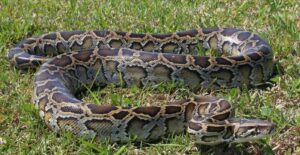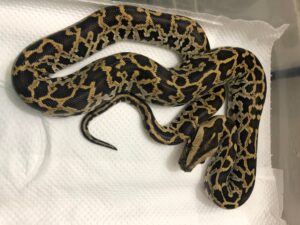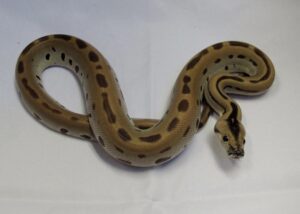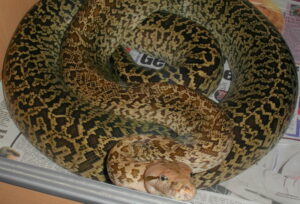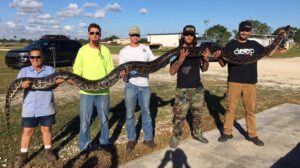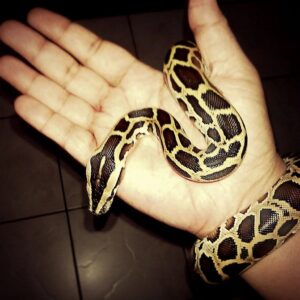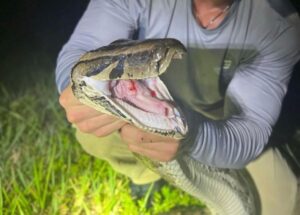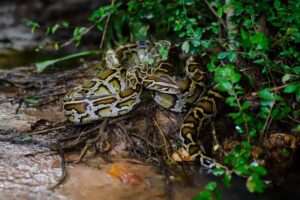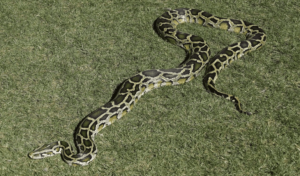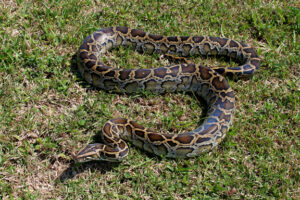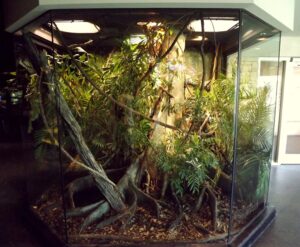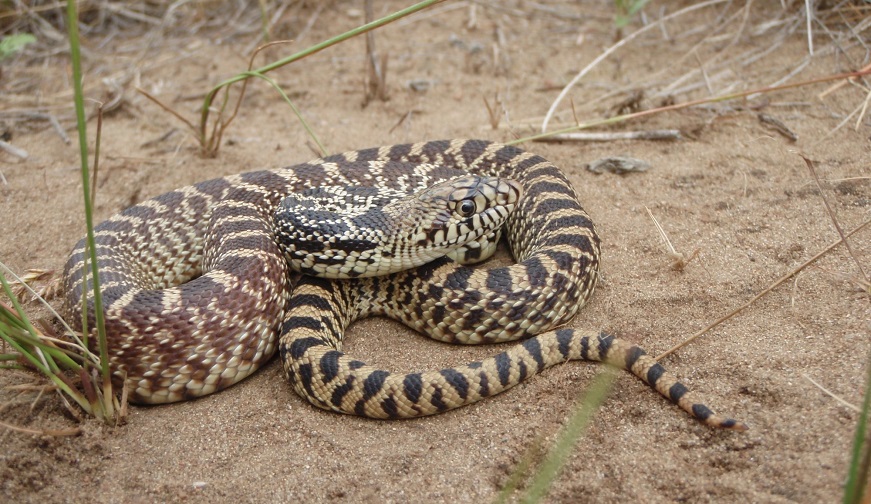The Burmese python, one of the largest snake species, is a nocturnal rainforest dweller. It is endemic to a large portion of southeast Asia. It is an invasive species, particularly in south Florida, with a large number present in the Florida Everglades. The pet trade has led to its infestation. The solitary snake is usually found in pairs only in the mating season.
When young, it exhibits both terrestrial and arboreal behavior, but as it gains girth, it tends to restrict its movements to the ground.
Scientific Classifications
- Suborder:Serpentes
- Family:Pythonidae
- Genus:Python
- Species:P. bivittatus
Conservation Status
Description
Size
In the wild, it typically grows to 16 ft (5 m), with the females being heavier, bulkier, and slightly longer than the males. Specimens more than 23 ft (7 m) are unconfirmed, and those more than 16 ft (5m) are rare. The wild Burmese pythons have an average length of 12 ft (3.7 m) but have been known to reach 18 ft 10 in (5.74 m).
The maximum recorded length is that of a female of 18 ft 10 in (5.74 m). She lived in Serpent Safari for 27 years. Widely published data of individuals several feet longer are unverified. At the time of her death, a Burmese python named Baby was the heaviest recorded snake at 403 lb (182.8 kg).
The minimum size for an adult is 7 ft 9 in (2.35 m). Dwarf forms occur in Bali, Java, and Sulawesi, with an average length of 6 ft 7 in (2 m) in Bali and a maximum of 8 ft 2 in (2.5 m) in Sulawesi.
Color and Appearance
The dark-colored snake has many brown blotches bordered with black on its back. The good climber has a prehensile tail.
Are They Dangerous to Humans
Both the juveniles and adults can quickly strike at the attacker if cornered. If pinned or grabbed, they can bite and hold on to the attacker while writhing and constricting.
The Burmese python, though non-venomous, can inflict an excruciating bite when trying to defend itself. It can have up to 100 large teeth that are curved and extremely sharp. A bite can cause puncture wounds and, if it is deep enough, can damage internal organs. But the non-aggressive snake bites only as a last resort.
Though docile, the powerful animal has the capability to kill by constriction.
Burmese Pythons at a Glance
Distribution
It lives throughout Southeast and Southern Asia, including eastern India, western Bhutan, southeastern Nepal, Myanmar, southeastern Bangladesh, Laos, Thailand, Cambodia, northern continental Malaysia, Vietnam, and southern China in Jiangxi, Fujian, Hainan, Guangdong, Yunnan, and Guangxi. It also occurs in Indonesia in south Sulawesi, Sumbawa, Bali, and Java. It has also been observed in Kinmen. Hong Kong also falls in its range.
In both its native and invasive range, the Burmese python suffers from a pentastome parasitic disease, Raillietiella orientalis. Its invasiveness in Florida has led other reptiles to be affected by the disease as the parasite appears to have become endemic to the state.
Habitat
It lives on marshes, swamps, grasslands, river valleys, woodlands, rocky foothills, and jungles with open clearings. The excellent swimmer needs a permanent source of water for survival. It can stay submerged in water for up to 30 minutes but mostly lives on land. It spends most of its time hidden in the underbrush. In the northern parts of its range, it can brumate for some months in the winter in a hole in the riverbank, hollow tree, or under rocks.
Though the aquatic marsh habitats act as excellent food sources for the invasive pythons, they tend to select environments where they can effectively camouflage. The specimens in Florida tend to prefer elevated habitats as it provides favorable conditions for nesting. Plus, edge habitats are places they frequent for thermoregulation, hunting, and nesting purposes. It is because the invasive populations are susceptible to cold stress with winter freezes resulting in mortality rates of up to 90%.
Lifespan
The python can live for up to 30 years.
Predators
The huge constrictor has just a few natural predators. Big cats like Asian tigers, leopards, king cobras, and humans can kill it.
Diet
The sit-and-wait predator mainly eats mammals and birds but also takes reptiles and amphibians. It grabs its prey with its sharp teeth and then wraps its body around it to kill it by constriction, after which it swallows its food whole. The Burmese python is often found near human habitation due to the presence of its prey, like mice, rats, and other vermin. But its equal favor for domestic birds and mammals has led it to be considered a pest.
The invasive population has led to a substantial decline in the numbers of rabbits, foxes, opossums, raccoons, white-tailed deer, and birds. It has even caused the disappearance of many mammal species. The exceptionally large snakes may even eat goats or pigs. They compete with alligators in their invasive range and attack the latter. Instances of them eating the reptile have been reported and recorded.
In contrast to the native South Asian counterparts who fast for extended periods (from 1 to 18 months) owing to seasonal variations in prey availability, the invasive individuals in Florida feed all year round as food is always available.
Reproduction
Oviparous (lays eggs that hatch outside the body)
The solitary species is found in pairs only when mating. After breeding in early spring, the females lay clutches of 12-36 eggs in March or April. She stays with the eggs until they hatch, wrapping her body around them and twitching her muscles to keep them warm.
The hatchlings use their egg teeth to cut their way out of the eggs and receive no maternal care. The newly hatched babies often stay inside the eggs until they are ready to finish their first skin shedding. Then they hunt on their own for their meals.
Similar Species
The ball python (Python regius) is smaller in size and lighter in weight. An average Burmese python is 16 ft (5 m) long with a weight of 200 lbs (90.72 kg), while on average, the ball python grows to 6 ft (1.83 m) in length and can weigh 7 lbs (3.18 kg) at the most.
The Burmese python has a dark V-shaped splotch on its head with a thick tan line traversing it. The ball python lacks this marking.
Anaconda
The anaconda is shorter, thicker, and heavier than the Burmese python.
Reticulated Python
The reticulated python (Malayopython reticulatus) has a more intricate and prominent pattern of black or dark brown markings against a lighter background. Its head is more triangular. The Burmese python has an irregular pattern of brown or gold markings against a darker background.
The boa constrictor is shorter and lighter than the Burmese python. Their length can be between 3 and 13 ft (1 and 4 m), and weighs up to 60 lbs (27 kg). Plus, it has saddle-shaped markings in contrast to the blotched pattern of the Burmese python.
Care Sheet
The docile and undemanding nature and attractive colors of the Burmese python have endeared it to the pet trade.
Size of the Enclosure: The babies can be housed in 20-gallon plastic containers, while the adults need a tank size of 5 ft (length) x 5 ft (width) x 10 ft (height).
Temperature: The temperature range in the cage should be 80°F-86°F.
Humidity: The snake needs high humidity levels of around 60%.
Substrate: Soil and artificial grass best replicates the python’s natural habitat. But if the owner finds this substrate difficult to maintain, he can use paper towels or newspaper that are easier to clean.
Feeding: The juveniles should be fed freshly thawed commercially available rats of appropriate size (almost the same width as the snake), gradually transitioning to bigger prey like poultry and rabbits as it grows. The feeding frequency should be every alternative week.
FAQs
Ans. Burmese pythons grow very fast. If power fed, they can exceed 6 ft 11 in (2.1) in a year. But it may cause health issues in the future. By the age of four, they reach the adult size though they continue to grow very slowly throughout their life.
Ans. The Burmese python is relatively cheaper than other pet snakes and can cost as low as $20. Some pet stores may sell them at $65-$80. Some morphs may cost more. The albino morph price can be as high as $500.
Source
critter.science, morphmarket.com, twincitiesreptiles.net, reptileforums.co.uk, sun-sentinel.com, reddit.com, d.newsweek.com, animalia.bio, badoca.com, usgs.gov, kingsnake.com, new.joshsfrogs.com

